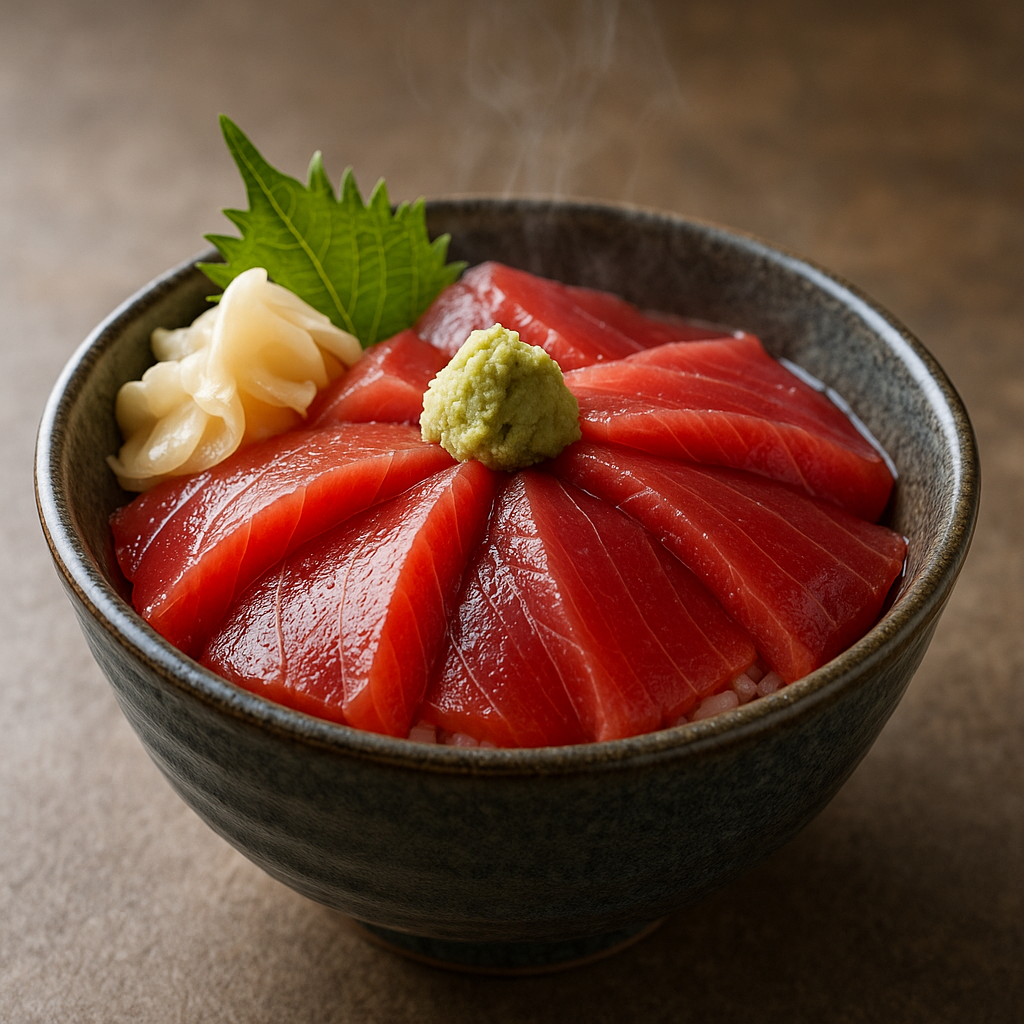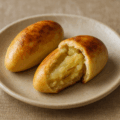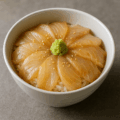マグロ丼(青森)の特徴
青森を代表する海鮮丼
マグロ丼は、青森県大間をはじめとする津軽海峡沿岸で水揚げされる新鮮なマグロを贅沢に使った海鮮丼です。特に大間の本マグロは全国的に有名で、脂の乗りと旨味が特徴です。
赤身から大トロまで楽しめる
部位によって異なる味わいが楽しめるのも魅力で、あっさりとした赤身、中トロのほどよい脂、大トロの濃厚な旨味を食べ比べることができます。
シンプルで豪華な一品
酢飯にマグロの切り身をのせるシンプルな構成ながら、その新鮮さと質の高さで豪華な料理として観光客や地元の人々に親しまれています。
マグロ丼(青森)のレシピ
材料(2人分)
- マグロ(赤身・中トロ・大トロお好みで) … 200g
- ご飯(酢飯) … 2膳分
- 醤油 … 適量
- わさび … 適量
- 刻み海苔 … 適量
- 大葉 … 2枚
作り方
- マグロを食べやすい厚さに切る。
- どんぶりに酢飯を盛り、大葉を敷く。
- マグロを美しく並べ、刻み海苔を散らす。
- 醤油とわさびを添えて完成。
シェフのワンポイントアドバイス
マグロは切る直前まで冷やしておくと鮮度が保たれ、色味も美しく仕上がります。酢飯は少し硬めに炊くと、マグロとのバランスが良くなります。
マグロ丼の栄養価(1人分の目安)
- エネルギー:約500〜600 kcal
- たんぱく質:30〜35 g
- 脂質:10〜20 g(部位による)
- 炭水化物:70〜80 g(ご飯由来)
- DHA・EPA(マグロ由来、血流改善や脳機能維持に効果)
- ビタミンB群(マグロ由来)
高たんぱくで良質な脂質を含み、栄養バランスに優れた海鮮丼です。
マグロ丼(青森)の歴史
大間の本マグロ
青森県大間は、日本有数の本マグロの産地として知られており、その漁獲されたマグロを使った丼は地元の名物料理です。
漁師飯から観光グルメへ
もともとは漁師たちが新鮮なマグロを手早く丼にして食べたのが始まりとされ、やがて観光客向けのグルメとして定着しました。
全国的な人気
現在では青森の代表的な海鮮料理として全国に知られ、観光やイベントでも広く提供されています。
English Version
Features of Tuna Bowl (Aomori)
A Signature Seafood Dish of Aomori
The Tuna Bowl is a specialty of Aomori Prefecture, especially famous in Oma along the Tsugaru Strait, where freshly caught tuna is generously served over rice. Oma’s bluefin tuna is renowned nationwide for its rich flavor and perfect balance of fat.
From Lean Cuts to Fatty Tuna
One of the highlights is the ability to enjoy different cuts of tuna—lean red meat with a clean taste, medium fatty tuna (chutoro) with balanced richness, and the luxurious fatty tuna (otoro) with its melt-in-your-mouth texture.
Simple Yet Luxurious
Although it is simply prepared with vinegared rice and sliced tuna, the freshness and quality of the fish make it a lavish dish loved by both locals and tourists.
Recipe
Ingredients (for 2 servings)
- Tuna (red meat, chutoro, or otoro as preferred) … 200 g
- Sushi rice … 2 bowls
- Soy sauce … to taste
- Wasabi … to taste
- Shredded nori … to taste
- Shiso leaf … 2 leaves
Instructions
- Slice the tuna into bite-sized pieces.
- Place sushi rice in bowls and lay a shiso leaf on top.
- Arrange the tuna slices neatly and sprinkle with shredded nori.
- Serve with soy sauce and wasabi on the side.
Chef’s Tip
Keep the tuna chilled until just before slicing to maintain freshness and color. Slightly firmer sushi rice pairs well with the tuna’s texture.
Nutritional Value (per serving, approx.)
- Calories: 500–600 kcal
- Protein: 30–35 g
- Fat: 10–20 g (depending on the cut)
- Carbohydrates: 70–80 g (mainly from rice)
- DHA & EPA (from tuna, beneficial for circulation and brain health)
- B vitamins (from tuna)
A high-protein dish with healthy fats, providing excellent nutritional balance.
Historical Background
Oma’s Famous Bluefin Tuna
Oma in Aomori Prefecture is one of Japan’s most renowned sources of premium bluefin tuna, and tuna bowls featuring this fish became a local specialty.
From Fishermen’s Meal to Tourist Cuisine
Originally enjoyed by fishermen as a quick and fresh meal, the tuna bowl evolved into a popular gourmet dish for visitors.
Nationwide Popularity
Today, tuna bowls from Aomori are widely recognized as one of Japan’s iconic seafood dishes and are served at restaurants and events across the country.



何でも質問してください!